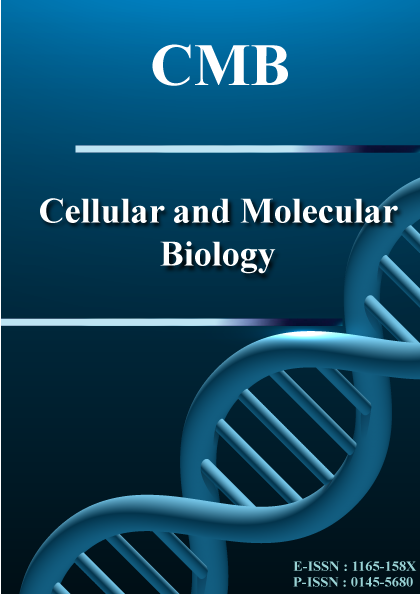Issue
Copyright (c) 2025 Nezar Boreak

This work is licensed under a Creative Commons Attribution-NonCommercial-NoDerivatives 4.0 International License.
The undersigned hereby assign all rights, included but not limited to copyright, for this manuscript to CMB Association upon its submission for consideration to publication on Cellular and Molecular Biology. The rights assigned include, but are not limited to, the sole and exclusive rights to license, sell, subsequently assign, derive, distribute, display and reproduce this manuscript, in whole or in part, in any format, electronic or otherwise, including those in existence at the time this agreement was signed. The authors hereby warrant that they have not granted or assigned, and shall not grant or assign, the aforementioned rights to any other person, firm, organization, or other entity. All rights are automatically restored to authors if this manuscript is not accepted for publication.Molecular signatures of endodontitis and pulpal inflammation: a comprehensive gene expression and multi-parameter analysis using GSE77459 microarray data
Corresponding Author(s) : Nezar Boreak
Cellular and Molecular Biology,
Vol. 71 No. 3: Issue 3
Abstract
Pulpal inflammation remains a significant endodontic challenge requiring improved molecular understanding for effective diagnosis and treatment. Current diagnostic methods largely depend on clinical assessments, necessitating molecular-level insights. This study aimed to analyze comprehensive gene expression profiles in pulpitis to identify potential diagnostic markers and understand underlying molecular mechanisms. We analyzed the GSE77459 dataset from Gene Expression Omnibus, comprising twelve pulpal tissue samples (six irreversible pulpitis and six normal controls). Gene expression profiling was performed using Affymetrix GeneTitan Multichannel Instrument. Pain assessment utilized visual analog scale (VAS) readings, with values >30mm indicating moderate to severe pain. Differential gene expression analysis was conducted using GEO2R, implementing a false discovery rate of 5%. Statistical significance was evaluated through adjusted p-values, log2 fold changes, and comprehensive visualization techniques including Volcano plots, Mean-Difference plots, and UMAP analysis. The analysis identified significant expression changes between inflamed and normal pulp tissues. Three genes showed notable upregulation: SNORD113-3 (log2FC: +0.71), RN5S290 (log2FC: +0.70), and SH3GL2 (log2FC: +0.67). Key downregulated genes included IGHV3-72 (log2FC: -1.66), IGKV1-5 (log2FC: -1.57), and IGHD (log2FC: -1.57). UMAP analysis revealed distinct clustering patterns between disease and control samples, while maintaining proximal positioning, indicating subtle yet consistent transcriptional differences. Statistical analysis showed that 62% of differentially expressed genes had significant adjusted p-values (<1e-8), with 25% exhibiting absolute log2FC values >1.2. This study reveals specific molecular signatures associated with pulpal inflammation, particularly highlighting the downregulation of immunoglobulin-related genes and upregulation of RNA processing factors. These findings provide potential molecular markers for pulpitis diagnosis and suggest new directions for therapeutic interventions in endodontic treatment.
Keywords
Download Citation
Endnote/Zotero/Mendeley (RIS)BibTeX




